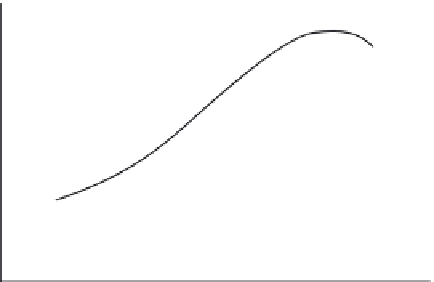Biomedical Engineering Reference
In-Depth Information
actual air
stoichiometric air
5
ER
ð
,
1
:
0
Þ
gasification
5
EA
ð
.
1
:
0
Þ
combustion
(8.12)
In a combustor, the amount of air supplied is determined by the stoichio-
metric (or theoretical) amount of air and its excess air coefficient.Ina
gasifier, the air supply is only a fraction of the stoichiometric amount. The
stoichiometric amount of air may be calculated based on the ultimate
analysis of the fuel.
ER dictates the performance of the gasifier. For example, pyrolysis takes
place in the absence of air and hence the ER is zero; for gasification of bio-
mass, it lies between 0.2 and 0.3.
Downdraft gasifiers give the best yield for ER—0.25 (Reed and Das,
1988, p. 25). With a lower ER value, the char is not fully converted into
gases. Some units deliberately operate with a low ER to maximize their char-
coal production. A lower ER gives rise to higher tar production. So, updraft
gasifiers, which typically operate with an ER of less than 0.25, have higher
tar content. With an ER above 0.25, some product gases are also burnt,
increasing the temperature.
The quality of gas obtained from a gasifier strongly depends on the value
of ER, which must be significantly below 1.0 to ensure that the fuel is gasi-
fied rather than combusted. However, an excessively low ER value (
0.2)
results in several problems, including incomplete gasification, excessive char
formation, and a low heating value of the product gas. On the other hand,
too high an ER (
,
0.4) results in excessive formation of products of complete
combustion, such as CO
2
and H
2
O, at the expense of desirable products,
such as CO and H
2
. This causes a decrease in the heating value of the gas.
In practical gasification systems,
.
the ER's value is normally maintained
within the range of 0.20
0.30.
Figure 8.20
shows the variation in carbon
100
90
80
70
60
50
40
0.15
0.2
0.25
0.3
Equivalence ratio
FIGURE 8.20
Effect of ER on carbon conversion in a fluidized-bed gasifier.
















Search WWH ::

Custom Search